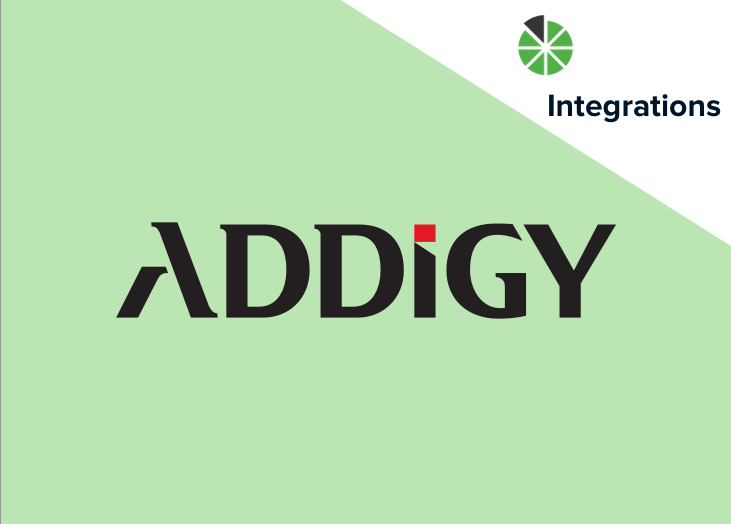We’re excited to welcome Natalie Dinkins to the team as a Customer Support Specialist! Join us in learning more about the newest member of our growing BrightGauge family… In the beginning Natalie was ...
We’re excited to welcome Natalie Dinkins to the team as a Customer Support Specialist! Join us in learning more about the newest member of our growing BrightGauge family… In the beginning Natalie was born in Brooklyn, New York, but grew up right here in South Florida. After graduating from Plantation High School, Natalie decided to stay local, attending Broward College for two years before earning her Bachelor’s degree from the University of Miami (C-A-N-E-S!). Later on, she also earned a Master’s degree from Florida International University. Since then, Natalie has explored several interesting avenues, working in energy conservation, higher education, and banking. Most recently, she was a Program/Project Manager for an all-women web development cohort. In that position, Natalie managed an all-women web development bootcamp, spearheading the project by recruiting students, providing input on the curriculum, and hiring teaching staff. That tech-focused role was the perfect springboard for the next opportunity in her career. Joining BrightGauge While going through the interview process here at BrightGauge, Natalie had a chance to meet several team members, who all talked a whole lot about how much they enjoyed their work. Plus, it was really clear that everyone truly loved working with one another, which gave Natalie the sense that this was a team she really wanted to be a part of. Aside from the culture, the opportunity to learn something new while applying her past skills and experience appealed to Natalie and solidified her decision to come on board! Next time you submit a support ticket, you may just hear from Natalie herself. Out of office Outside of work, you can find Natalie spending time with her siblings, whether they’re tailgating at a football game or barbecuing in the park. And recently, Natalie has rekindled her love for running, but it’s a love that sometimes goes unfulfilled. “Between the extreme heat and torrential downpours, running outdoors in South Florida can be a challenge,” says Natalie. Ain’t that the truth!

As a BrightGauge user, you probably have multiple datasources you connect with. Many MSPs use a PSA like ConnectWise, an RMM like Datto, and a financial tool like Quickbooks to stay on top of all their important metrics. BrightGauge simplifies the way you monitor your data by putting all these metrics in one easy-to-access place. But did you know that, with BrightGauge, you can actually combine data from your different integrations into one super-powered gauge? It’s called data mashup and it’s pretty good if we do say so ourselves. What is a data mashup? The data mashup feature allows you to combine multiple sets of information and display them together for easy comparison. The first thing you should know is that this feature is only available to our users on the Enterprise Plan (if you want to upgrade your plan, here’s how to do it). The second thing to note is that there are two types of mashups: dataset and datasource. How do I create data mashups? The method for making a data mashup varies depending on whether you're mashing up datasets or datasources. Dataset mashups let you combine two or more datasets into a single gauge by layering the datasets together. For example, perhaps you’d like to see how many tickets each technician is resolving and how much time is being entered by that technician. That’s a dataset mashup that puts those metrics side by side. Here's an example of a dataset mashup: Datasource mashups are really similar to dataset mashups, but are pulled from two or more sources. Let’s say you use ConnectWise Manage and SmileBack. The data mashup feature would allow you to pull in metrics from both of those tools into one seamless gauge. When monitoring something like Tickets Resolved and CSAT by Tech, this feature is essential. Here's an example of a datasource mashup: BrightGauge makes it easy to create both dataset and datasource mashups by allowing you to easily define different datasets and/or datasources to combine. Simply select the datasets or datasources you want to use and plug them into a single data dashboard. The bar charts shown above are only one type of data mashup display. Depending on your needs or preferences, you can also create funnel charts, dials, circle graphs, or many more displays. What are the benefits of the data mashup feature? Combining your datasets or datasources will allow you to gain more powerful insights than if you were to track each piece of data separately. In some instances, it can even give you insights that you would not have seen without mashing up your data. Anything that makes your dashboards even stronger is going to help you make better business decisions that impact your bottom line. Above, we showed you what it would look like to see tickets resolved versus hours entered by technician. As a business manager, imagine using this gauge to make decisions about your team’s performance. You could use it to track multiple aspects of an employee's performance, then use that information to help them improve their productivity. For example, you could pull some ticket statistics and member data to create a technician utilization chart: An example of how to use a data mashup You may discover that one technician’s ratio of hours entered to tickets resolved isn’t adding up. They’re entering way too much time but not resolving many tickets within that time frame. Armed with this insight, you could approach that technician to see if something is going on that’s preventing them from answering more tickets. Or, if this is a pattern that’s developed over time, you may discover that this technician is no longer a right fit for your team. Or, you may even find that your team is overloaded and you need to add another member to your team. It's possible that this particular employee is being made to handle extra-complicated issues because that's their field of expertise and others can't handle it—leaving them to handle more time-consuming tasks than their peers. These are insights that you simply may have missed had you been tracking the data separately. By combining data in a data mashup, you can more easily identify these kinds of issues. This allows you to take the appropriate action to improve your team's efficiency, productivity, and results. BrightGauge data dashboards were designed to help you make sense of your KPIs and to help you make better and faster business decisions. Data mashups are like a dashboard superpower that make you an even stronger business leader. You can upgrade your plan today to gain access to this great feature.

We’re excited to welcome Christopher Turpin to the team as a Customer Support Specialist! Join us in learning more about the newest member of our growing BrightGauge family… In the beginning Christopher calls Plantation, Florida his hometown, but was lucky enough to experience the best of both worlds - splitting his childhood between New York and Miami and getting a taste of what few native Floridians do: seasons. While in New York, Christopher also spent a lot of time with his grandparents, up in Syracuse. When it came time to choose a university, Christopher opted for warmer weather and stayed put in South Florida, attending Florida International University, making him a proud Golden Panther. In 2017, Christopher attended Wyncode (like many other BrightGaugers!) in an effort to better understand how apps work behind the scenes and in hopes to one day build his own app. Most recently, he put what he learned at Wyncode to work as a Junior Developer at a local startup company called Wahii. Joining BrightGauge Through his peers from Wyncode, Christopher learned of an opportunity at BrightGauge and was drawn to the idea of working closely on an app. The entire interview process proved to be such a great experience, making him eager to join the team. In his words, “Everyone made me feel at ease and the atmosphere was so down to earth, it was like everyone was family.” Yeah, we feel that way, too! Christopher is looking forward to helping out BrightGauge customers, as well as expanding his SQL knowledge. Out of office *in case you couldn't tell, this is a throwback photo! :) When not in the office, Christopher entertains himself with his many interests, like discovering new music, watching a great movie, or binging on an addictive series. You can also find him playing video games and soccer. Heads up: Christopher is a self-proclaimed sneakerhead, so if you know of a good spot to check out, let him know!

We’re excited to welcome Anthony Cook to the team as an Integration Developer! Join us in learning more about the newest member of our growing BrightGauge family… In the beginning Anthony brings a fresh perspective to us - he is one of the few BrightGaugers who is not originally from the South Florida area! He was born and raised mainly in Brooklyn, New York. When he was in high school, Anthony’s mom decided to relocate the family to Georgia, as their neighborhood in Brooklyn was not the best. Anthony was in Georgia through high school and for his first year of college, but eventually was craving the city life once again. Inevitably, Anthony ended up in South Florida, where he finished his bachelor’s in Digital Media Studies at Florida International University. Two years ago, he went back to school to earn his MBA at Lynn University. While there, he learned of Lynn University’s partnership with Wyncode, and decided to take the steps needed to become a programmer. After graduating, Anthony worked at Promero, Inc. in Pompano Beach. There, he wrote code to build chatbots using the Oracle Digital Assistant platform and the Oracle Mobile Cloud environment. These chatbots were integrated with backend systems such as Salesforce. Joining BrightGauge Anthony’s former Wyncode instructor and current programming mentor, Auston, informed him of BrightGauge and existing opportunities. Anthony had been seeking a more collaborative environment, so decided to apply for the Integration Developer position. Anthony said he had heard great things about the BrightGauge culture and was looking for a place where he could learn from many talented developers. We felt he could bring a lot to the table and are so excited to have him in our group! As Anthony says, “I’m most excited about becoming a stronger Python programmer and expanding my technical knowledge base. I want to learn anything and everything I can from anyone and everyone here.” Out of office When Anthony’s not impressing us with his knowledge (and gif game) at work, you can find him playing video games, listening to rap, indulging his passion of literature and poetry, and working on his own novel. He’s also big into public speaking. Recently, he spoke at an event sponsored by BET about the growing black tech community. It’s his hope to speak with more African-Americans about the opportunities that come with a career in STEM and to defeat certain perceptions about how one becomes a programmer. We’re so proud to have such a forward-thinker on our team.

Announcing the latest feature now available to BrightGauge customers: Public Dashboards. With this feature, you can share your top boards and key performance indicators (KPIs) with stakeholders, clients, internal teams, or whomever you want. How Public Dashboards work Essentially, Public Dashboards are shared via an auto-generated URL that we provide within the BrightGauge app. The dashboards will be read-only, so anyone with access to the link will simply be able to view the data without the ability to manipulate any of the gauges. On your end, you would go to the dashboard you want to share, designate it as a public URL, and obtain a link. Anyone who receives the link will be able to view your dashboard without needing to sign in. If at any time you disable the public URL, the link will no longer function. Public Dashboards sync and update just like they do within the BrightGauge app. In your BrightGauge, you’ll know if a dashboard has been designated as public because there will be a green PUBLIC label next to the title of your board. Here you can see a dashboard in the wild. What should I do with Public Dashboards? Well, the world is your oyster! Share these however and with whomever you want. Some customers have already told us that they’re loving this feature because it allows them to display their dashboards on multiple TVs/monitors without needing logins or special software or hardware. For our users who can’t see their clients at the frequency they would like to, being able to share a Public Dashboard is a great way to keep them in the loop on the work they’re doing and show how they’re tracking against their SLAs. Users who work for really large companies may share Public Dashboards internally to show KPI progress with other team members without needing to give everyone their own BrightGauge login. There are so many possibilities when it comes to Public Dashboards, so be sure to share your use cases with us. Please note, Public Dashboards are available at Enterprise-level plans only. Learn more about how to set up your Public Dashboards here or submit a support ticket if you’ve got questions at any time.

70+ Metrics for MSPs
Key metrics and accompanying formulas to help MSPs skyrocket growth and success!
Get your KPIs
Ask any service desk managers about the key performance indicators (KPIs) they are tracking, and we're willing to bet that Kill Rate Percentage is highly likely to be on their list. This KPI takes a look at your ratio of closed to open tickets, informing you of how well you're doing at staying ahead of your backlog and moving through your ticket queue. Ideally, you want your Kill Rate % to be equal to or greater than 100% for a given period, as that means you've closed more tickets than were opened. This quick tutorial video shows you how to build a simple Kill Rate Percentage gauge within BrightGauge using a PSA. If you have questions at any time, please feel free to reach out to our support team! For more KPIs and tutorial videos, check us out on YouTube.

If you’re like us, or like many of our customers, you have multiple screens around your office displaying BrightGauge dashboards. Maybe you have TVs in your various departments showing data relevant to that team. Or perhaps you have a dedicated dashboard area, where a bunch of monitors are displaying different metrics side-by-side. Whatever the case may be, if at any time you need to check the status of one dashboard, it’s probably not as quick or seamless as you’d like. We ourselves have struggled to find a solution that lets us modify all of our displayed dashboards from one central location. However, BrightGauge user Ammon Lane-Ramsey of Live Consulting recently introduced us to Stardock, which is a great option for anyone using multiple dashboards. What is Stardock? Stardock is a provider of multiple solutions, and the one we are talking about here is Multiplicity, which is a wireless KVM software solution. It lets you connect multiple PCs to one switch and do work across all those PCs seamlessly. You may be familiar with traditional KVM hardware, but Multiplicity eliminates the need for any cables or extra KVM switches. With Multiplicity, you basically install the software on one computer and use that main PC as your control panel for all others. As long as all computers are running on the same network, you’ll be good to go. How Multiplicity is used at Live Consulting Around Live Consulting, there are 8 screens being used to show BrightGauge data and each screen has a physical computer hooked up to it. In the past, a VNC viewer was used to manage all the screens, but it was clunky and took a long time to use. Ammon says that on Monday mornings, he would walk around checking in on all the dashboards, and if anything was off, he’d have to jump onto that specific computer and make necessary changes. Doing this multiple times a week - or even day - was not an efficient use of time. “Now, I have Multiplicity installed on my own computer and any other computers I want to track,” says Ammon. “Throughout the day, I’ll open my control panel, take a look at all my dashboards from there, and see how my team is performing or if there are any adjustments I need to make.” It’s simply a matter of right-clicking on your Multiplicity KVM, choosing whatever screen you want to look at, and taking it from there. For Ammon and Live Consulting, the use of BrightGauge and Multiplicity has helped make the team more productive. “From my office, I can take a look at all these various BrightGauge dashboards and see the status of my teams,” says Ammon. “If I see a lot of red, I can ask what’s needed, how I can help. If I see a lot of green, I know things are running smoothly. We’ve been able to fine-tune the way we deliver service by having access to this kind of data.” When it comes to data, managing it in a seamless way is priceless, because data can scare people, so it helps to make sense of it. Easy access to data can provide the context needed to understand and improve upon the business as a whole. The control panel is not the only benefit of using Multiplicity. Ammon himself likes to have as many monitors as possible and uses 4 in his own office. 2 are hooked up to one computer and the other 2 to a separate computer. Having Multiplicity installed on both computers lets him literally move through all 4 monitors regardless of which computer they’re hooked up to, making it easy to move across files and tasks seamlessly. “It’s a very simple product,” says Ammon. “But what it does is pretty powerful in terms of lending itself to higher efficiency and minimizing the need to run around your office to get things done.” Learn more about Stardock’s Multiplicity solution or contact BrightGauge today if you have any questions.

When it comes to client reports, you understand that a little transparency goes a long way. Showing your clients the work you’re doing - both the good and the bad - is a powerful way to build trust, and trust lays the foundation for long-term relationships, which is great for your business. But you may not always know exactly what to include in your client reports. This is where it helps to hear from some friends in the industry. In our upcoming customer showcase webinar, BrightGauge user Brett Baz, Operations Manager for C3Group, will give a glimpse into how he and his team are using BrightGauge reports to cover all aspects of the customer lifecycle. He’ll share the report templates he’s using, how he chooses the right metrics to share, and how this impacts the team at C3Group. Plus, we’ll let you in on what’s new within BrightGauge. Sometimes, seeing how your peers are using different BrightGauge features can spark some inspiration and show you new ways to get set up for success, so it’s worth joining the webinar and seeing what you can learn! ‘Covering Customer Touchpoints with Reports’ featuring Brett Baz will take place on Wednesday, June 19th at 7:30pm EST/Thursday, June 20th at 9:30am AEST. RSVP now:

Question: How many different programs, web-tools or items of software do you use a day? Sure, all the tools you use add value. But with more tools comes more data points, more logins and, ultimately, more time spent analyzing trends and results. If all your important data and KPIs could be monitored in one place, it would save you time and increase your productivity and efficiency, right? That’s why business intelligence tools - like BrightGauge - matter so much. Even the customer satisfaction pros at SmileBack, and their clients, turn to BrightGauge to integrate all of their CSAT metrics into one single dashboard. We spoke to Eben Marks, Customer Success Manager at SmileBack, to learn more. CSAT pros putting their money where their mouths are As the team behind a successful CSAT survey, it would be hypocritical if SmileBack didn’t track their own performance. Within their own Customer Success department, the folks at SmileBack spend time keeping up to date with the total amount of support tickets they have, how many tickets have been replied to, and by whom. “Quite simply, we needed one place where we could monitor support tickets, our own satisfaction scores and more in one place,” says Eben Marks, Customer Success Manager at SmileBack. “And that’s what we’re getting with BrightGauge.” Through the data points they track, each team member receives a CSAT rating, which they use to improve processes. By implementing BrightGauge into their daily use, the team at SmileBack has benefited from quicker, stronger insights into their CSAT data. With a simple glance at their dashboard at any point throughout the day, Eben and his team are able to assess if they’re meeting customer needs or if they may be falling short. They see their survey reactions in real-time, which empowers them to make immediate changes, if necessary. Overall, it has made the department more productive. “Understandably so, some of our goals revolve around our CSAT performance. We’re also using BrightGauge to track those goals,” says Eben. “It’s a simple system because your relevant numbers for the goal you want to achieve are displayed in red or green, so you know quickly whether you’re on or off track.” There are around 40 different datasources that you can display at any one time, making BrightGauge a powerful dashboard for the team to monitor, but also to display on TV screens or individual monitors if we need it. "SmileBack integrates with BrightGauge, but we're also happy to personally use the integration ourselves because it has helped us understand our data better,” says Eben. What SmileBack clients have to say For Adam Hannemann, Director of Managed Services at Imagine IT, the SmileBack integration with BrightGauge is one of their key tools for daily work. “We use BrightGauge for pretty much everything” says Adam. Imagine IT has several users internally that essentially get their next work from a dashboard to make sure the right things are being worked on at the right time. “We have TVs up in our service desk area that show dashboards specific to service-related items, then we have another dashboard for our Depot/Account Management/NOC that cycles through data relevant to those departments. We also have several users that dedicate a single monitor on their desk (our standard is 4 monitors) for a BrightGauge dashboard,” says Adam. A KPI they’re constantly looking at on those dashboards? A running tally of their SmileBack scores, plus a week-over-week gauge. This helps them keep an eye on their streaks of positive reactions. It’s a similar story for Edward Aronyk for MSP Keeran Networks, who could not do client reporting today without BrightGauge – at least not this easily. “It’s very powerful, but also pretty straightforward to use. We’ve used competing products in the past but BrightGauge is way more brain friendly,” says Edward. “With the SmileBack integration, we can include CSAT data in our QBR reports for when we sit down with our clients, and the monthly summary reports we email them. SmileBack can print a nice report too, but I like that BrightGauge integrates all of our datasources into a single report.” About the SmileBack + BrightGauge integration When you integrate SmileBack + BrightGauge, you’re going to get 34 default KPIs, 3 pre-built dashboards, and 2 report templates to get you started. That way, you can start viewing your essential CSAT data (and data from your RMM, PSA, finance, or other tool you’re using) immediately. Some of the default KPIs that come with the integration include: Average CSAT % Last 90 Days CSAT Per Resource Days Since Last Negative Reaction Net CSAT Score Positive Reactions Total Reactions To learn more about SmileBack + BrightGauge, please contact us today. For more on why CSAT surveys matter and how to create effective ones, download our whitepaper ‘Customer Satisfaction Surveys That Work’.

Do you use or manage Apple devices in your MSP? If so, this is an integration you're going to want to pay attention to! As Apple products continue growing in popularity, we’ve heard loud and clear that our MSP customers are ready to include that data in their BrightGauge, alongside all the other metrics that run their business. And because Addigy focuses exclusively on Mac assets, their comprehensive data helps you to maintain a secure, up-to-date Apple portfolio. How to Use Addigy + BrightGauge to Make Data Driven Decisions Utilizing your own KPIs, you can view your top-level business metrics or zero in on system views. That means everyone from your Executive team to your front-line Support can access the data they need to perform at their best, every day. Plus, keeping your Addigy data in your BrightGauge dashboard gives you the ability to see what your Mac networks are doing in real-time, making it easier than ever to increase uptime and address issues preemptively. Addigy Machine Monitoring With a machine monitoring dashboard, you’ll see drive statuses at a glance and be able to address vulnerabilities before a machine becomes compromised. Addigy Executive Report Templates Using an Addigy report template that’s easy to customize, you’ll always be able to show your clients the value of the services you provide. Client reporting is simple to set up, and each one can be automatically generated and filled with the data they want to see, when they want to see it. Customized, Complex Gauge Building When you’re managing dozens or hundreds of Apple products across multiple networks, having the ability to monitor all asset trends at once saves you the time and frustration of manually compiling the data. For example, with a System Health Details by Policy gauge in place, you can clearly see how Encryption Health is stacking up compared to Warranty Health, Security Health, and more, across all of the organizations you manage. By the way, when you connect Addigy + BrightGauge, you'll automatically get default KPIs and templates in your account. Get started with 38 default gauges, 2 pre-built dashboards, and 1 report template. Avoid any downtime and get the data you need at your fingertips right off the bat. To learn more about how you can make data driven decisions for your Apple-based networks, please visit Addigy + BrightGauge, or click here to try a free trial of Addigy's Mac network monitoring.

As you may know, we recently launched the ability to embed your gauges on public sites. This is an awesome way to show off your KPIs and let prospects and customers alike know a bit about what they can expect from you as a trusted partner. For example, embedding your Average Response Time or your CSAT scores on your marketing site can reveal to viewers that you're committed to providing excellent service. That being said, there's no need to limit yourself to external sites. We've been talking to BrightGauge users and have found that embeddable gauges are also a powerful way to boost visibility and transparency amongst your internal teams. In a recent webinar, we spoke to customer Justin Bryant, the Director of Quality Assurance for C Spire, to learn how he's using embeddable gauges to build an internal service library using the ITIL framework. The shared library allows team members from every department to see how the company as a whole is tracking against certain KPIs, which works to motivate and align everyone in the organization. Additionally, the webinar covers operational maturity, how to create the public gauges within BrightGauge, how to set up a KPI library, and how to share those KPIs. Watch now as Justin takes us through his service library and see how embeddable gauges can help make you more productive and focused.












